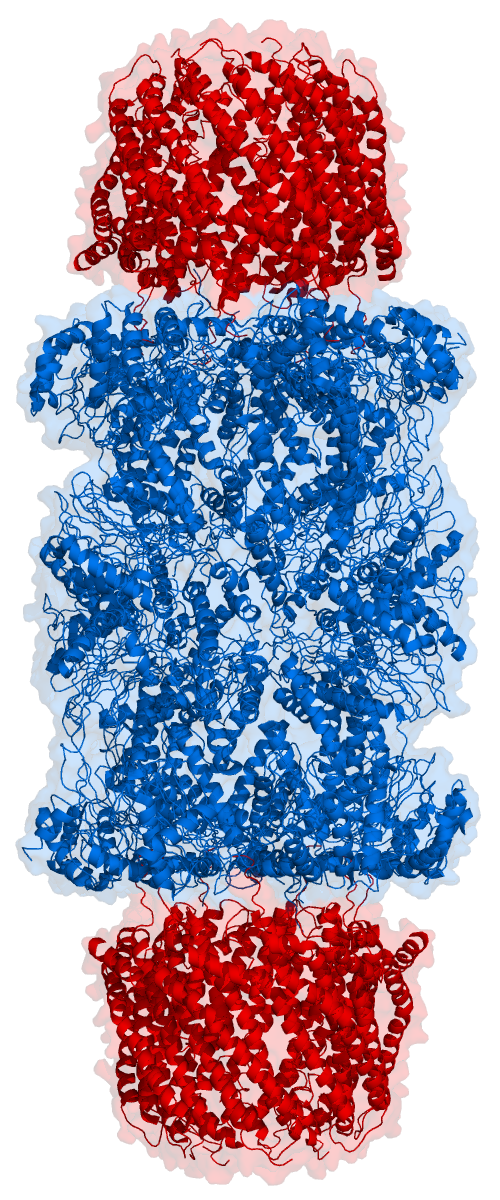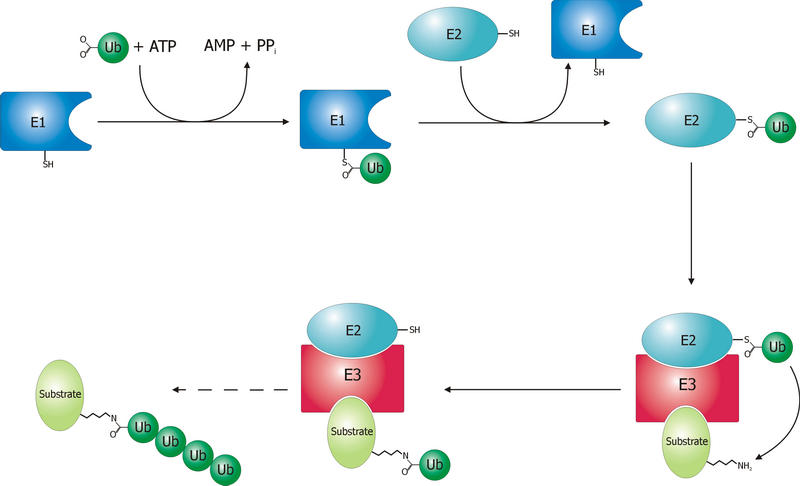|
SMAD1
Mothers against decapentaplegic homolog 1 also known as SMAD family member 1 or SMAD1 is a protein that in humans is encoded by the ''SMAD1'' gene. Nomenclature SMAD1 belongs to the SMAD, a family of proteins similar to the gene products of the ''Drosophila'' gene 'mothers against decapentaplegic' (Mad) and the ''C. elegans'' gene Sma. The name is a combination of the two; and based on a tradition of such unusual naming within the gene research community. It was found that a mutation in the 'Drosophila' gene, ''MAD'', in the mother, repressed the gene, ''decapentaplegic'', in the embryo. Mad mutations can be placed in an allelic series based on the relative severity of the maternal effect enhancement of weak dpp alleles, thus explaining the name Mothers against dpp. Function SMAD proteins are signal transducers and transcriptional modulators that mediate multiple signaling pathways. This protein mediates the signals of the bone morphogenetic proteins (BMPs), which are involved ... [...More Info...] [...Related Items...] OR: [Wikipedia] [Google] [Baidu] |
SMAD4
SMAD4, also called SMAD family member 4, Mothers against decapentaplegic homolog 4, or DPC4 (Deleted in Pancreatic Cancer-4) is a highly conserved protein present in all metazoans. It belongs to the SMAD family of transcription factor proteins, which act as mediators of TGF-β signal transduction. The TGFβ family of cytokines regulates critical processes during the lifecycle of metazoans, with important roles during embryo development, tissue homeostasis, regeneration, and immune regulation. SMAD 4 belongs to the co-SMAD group (''common mediator'' SMAD), the second class of the SMAD family. SMAD4 is the only known co-SMAD in most metazoans. It also belongs to the Darwin family of proteins that modulate members of the TGFβ protein superfamily, a family of proteins that all play a role in the regulation of cellular responses. Mammalian SMAD4 is a homolog of the ''Drosophila'' protein "Mothers against decapentaplegic" named Medea. SMAD4 interacts with R-Smads, such as SMAD2, SMA ... [...More Info...] [...Related Items...] OR: [Wikipedia] [Google] [Baidu] |
R-SMAD
R-SMADs are receptor-regulated SMADs. SMADs are transcription factors that transduce extracellular TGF-β superfamily ligand signaling from cell membrane bound TGF-β receptors into the nucleus where they activate transcription TGF-β target genes. R-SMADS are directly phosphorylated on their c-terminus by type 1 TGF-β receptors through their intracellular kinase domain, leading to r-SMAD activation. R-SMADS include SMAD2 and SMAD3 from the TGF-β/Activin/Nodal branch, and SMAD1, SMAD5 and SMAD8 from the BMP/GDP branch of TGF-β signaling. In response to signals by the TGF-β superfamily of ligands these proteins associate with receptor kinases and are phosphorylated at an SSXS motif at their extreme C-terminus. These proteins then typically bind to the common mediator Smad or co-SMAD SMAD4. Smad complexes then accumulate in the cell nucleus where they regulate transcription of specific target genes: * SMAD2 and SMAD3 are activated in response to TGF-β/ Activin or Nodal sign ... [...More Info...] [...Related Items...] OR: [Wikipedia] [Google] [Baidu] |
Bone Morphogenetic Protein
Bone morphogenetic proteins (BMPs) are a group of growth factors also known as cytokines and as metabologens. Originally discovered by their ability to induce the formation of bone and cartilage, BMPs are now considered to constitute a group of pivotal morphogenetic signals, orchestrating tissue architecture throughout the body. The important functioning of BMP signals in physiology is emphasized by the multitude of roles for dysregulated BMP signalling in pathological processes. Cancerous disease often involves misregulation of the BMP signalling system. Absence of BMP signalling is, for instance, an important factor in the progression of colon cancer, and conversely, overactivation of BMP signalling following reflux-induced esophagitis provokes Barrett's esophagus and is thus instrumental in the development of esophageal adenocarcinoma. Recombinant human BMPs (rhBMPs) are used in orthopedic applications such as spinal fusions, nonunions, and oral surgery. rhBMP-2 and rhBMP-7 are F ... [...More Info...] [...Related Items...] OR: [Wikipedia] [Google] [Baidu] |
Protein
Proteins are large biomolecules and macromolecules that comprise one or more long chains of amino acid residues. Proteins perform a vast array of functions within organisms, including catalysing metabolic reactions, DNA replication, responding to stimuli, providing structure to cells and organisms, and transporting molecules from one location to another. Proteins differ from one another primarily in their sequence of amino acids, which is dictated by the nucleotide sequence of their genes, and which usually results in protein folding into a specific 3D structure that determines its activity. A linear chain of amino acid residues is called a polypeptide. A protein contains at least one long polypeptide. Short polypeptides, containing less than 20–30 residues, are rarely considered to be proteins and are commonly called peptides. The individual amino acid residues are bonded together by peptide bonds and adjacent amino acid residues. The sequence of amino acid residue ... [...More Info...] [...Related Items...] OR: [Wikipedia] [Google] [Baidu] |
Developmental Genes And Proteins
Development of the human body is the process of growth to maturity. The process begins with fertilization, where an egg released from the ovary of a female is penetrated by a sperm cell from a male. The resulting zygote develops through mitosis and cell differentiation, and the resulting embryo then implants in the uterus, where the embryo continues development through a fetal stage until birth. Further growth and development continues after birth, and includes both physical and psychological development, influenced by genetic, hormonal, environmental and other factors. This continues throughout life: through childhood and adolescence into adulthood. Before birth Development before birth, or prenatal development () is the process in which a zygote, and later an embryo and then a fetus develops during gestation. Prenatal development starts with fertilization and the formation of the zygote, the first stage in embryonic development which continues in fetal development until b ... [...More Info...] [...Related Items...] OR: [Wikipedia] [Google] [Baidu] |
Transcription Factors
In molecular biology, a transcription factor (TF) (or sequence-specific DNA-binding factor) is a protein that controls the rate of transcription of genetic information from DNA to messenger RNA, by binding to a specific DNA sequence. The function of TFs is to regulate—turn on and off—genes in order to make sure that they are expressed in the desired cells at the right time and in the right amount throughout the life of the cell and the organism. Groups of TFs function in a coordinated fashion to direct cell division, cell growth, and cell death throughout life; cell migration and organization (body plan) during embryonic development; and intermittently in response to signals from outside the cell, such as a hormone. There are up to 1600 TFs in the human genome. Transcription factors are members of the proteome as well as regulome. TFs work alone or with other proteins in a complex, by promoting (as an activator), or blocking (as a repressor) the recruitment of RNA po ... [...More Info...] [...Related Items...] OR: [Wikipedia] [Google] [Baidu] |
Proteasome-mediated Degradation
Proteasomes are protein complexes which degrade unneeded or damaged proteins by proteolysis, a chemical reaction that breaks peptide bonds. Enzymes that help such reactions are called proteases. Proteasomes are part of a major mechanism by which cells regulate the concentration of particular proteins and degrade misfolded proteins. Proteins are tagged for degradation with a small protein called ubiquitin. The tagging reaction is catalyzed by enzymes called ubiquitin ligases. Once a protein is tagged with a single ubiquitin molecule, this is a signal to other ligases to attach additional ubiquitin molecules. The result is a ''polyubiquitin chain'' that is bound by the proteasome, allowing it to degrade the tagged protein. The degradation process yields peptides of about seven to eight amino acids long, which can then be further degraded into shorter amino acid sequences and used in synthesizing new proteins. Proteasomes are found inside all eukaryotes and archaea, and in some ... [...More Info...] [...Related Items...] OR: [Wikipedia] [Google] [Baidu] |
SMURF2
E3 ubiquitin-protein ligase SMURF2 is an enzyme that in humans is encoded by the ''SMURF2'' gene which is located at chromosome 17q23.3-q24.1. Interactions SMURF2 has been shown to interact with: * Mothers against decapentaplegic homolog 1, * Mothers against decapentaplegic homolog 2, * Mothers against decapentaplegic homolog 3, * Mothers against decapentaplegic homolog 7, * SCYE1, * SMURF1, and * Ubiquitin C. * TOP2A DNA topoisomerase IIα is a human enzyme encoded by the ''TOP2A'' gene. Topoisomerase IIα relives topological DNA stress during transcription, condenses chromosomes, and separates chromatids. It catalyzes the transient breaking and rejoining of ..., References Further reading * * * * * * * * * * * * * * * * {{Gene-17-stub ... [...More Info...] [...Related Items...] OR: [Wikipedia] [Google] [Baidu] |
SMURF1
E3 ubiquitin-protein ligase SMURF1 is an enzyme that in humans is encoded by the ''SMURF1'' gene. Function This gene encodes a ubiquitin ligase that is specific for receptor-regulated SMAD proteins in the bone morphogenetic protein ( BMP) pathway. A similar protein in ''Xenopus'' is involved in embryonic pattern formation. Alternative splicing results in multiple transcript variants encoding different isoforms. An additional transcript variant has been identified, but its full length sequence has not been determined. Interactions SMURF1 has been shown to interact with: * ARHGEF9, * PLEKHO1, and * SMURF2 E3 ubiquitin-protein ligase SMURF2 is an enzyme that in humans is encoded by the ''SMURF2'' gene which is located at chromosome 17q23.3-q24.1. Interactions SMURF2 has been shown to interact with: * Mothers against decapentaplegic homolog 1, * .... References Further reading * * * * * * * * * * * * * * External links * {{protein-stub ... [...More Info...] [...Related Items...] OR: [Wikipedia] [Google] [Baidu] |
E3 Ubiquitin Ligase
A ubiquitin ligase (also called an E3 ubiquitin ligase) is a protein that recruits an E2 ubiquitin-conjugating enzyme that has been loaded with ubiquitin, recognizes a protein substrate, and assists or directly catalyzes the transfer of ubiquitin from the E2 to the protein substrate. In simple and more general terms, the ligase enables movement of ubiquitin from a ubiquitin carrier to another thing (the substrate) by some mechanism. The ubiquitin, once it reaches its destination, ends up being attached by an isopeptide bond to a lysine residue, which is part of the target protein. E3 ligases interact with both the target protein and the E2 enzyme, and so impart substrate specificity to the E2. Commonly, E3s polyubiquitinate their substrate with Lys48-linked chains of ubiquitin, targeting the substrate for destruction by the proteasome. However, many other types of linkages are possible and alter a protein's activity, interactions, or localization. Ubiquitination by E3 ligases regu ... [...More Info...] [...Related Items...] OR: [Wikipedia] [Google] [Baidu] |
Phosphorylation
In chemistry, phosphorylation is the attachment of a phosphate group to a molecule or an ion. This process and its inverse, dephosphorylation, are common in biology and could be driven by natural selection. Text was copied from this source, which is available under a Creative Commons Attribution 4.0 International License. Protein phosphorylation often activates (or deactivates) many enzymes. Glucose Phosphorylation of sugars is often the first stage in their catabolism. Phosphorylation allows cells to accumulate sugars because the phosphate group prevents the molecules from diffusing back across their transporter. Phosphorylation of glucose is a key reaction in sugar metabolism. The chemical equation for the conversion of D-glucose to D-glucose-6-phosphate in the first step of glycolysis is given by :D-glucose + ATP → D-glucose-6-phosphate + ADP : ΔG° = −16.7 kJ/mol (° indicates measurement at standard condition) Hepatic cells are freely permeable to glucose, and ... [...More Info...] [...Related Items...] OR: [Wikipedia] [Google] [Baidu] |




